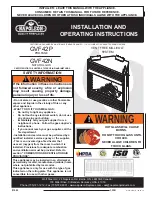
Motor runs, fuel sprays, but no spark is observed
Causes:
1. Electrodes damaged or gapped incorrectly.
2. Transformer defective.
3. Control board defective.
Solutions:
1. Electrodes damaged or gapped incorrectly. Inspect the electrode tips for melting. Make sure there are no cracks in the porcelain insulation.
Check the electrodes with the manufacturer’s specifications for gapping and spacing. Adjust or replace the electrodes as needed.
2. Transformer defective. Transformers require a ground connection to function properly. Check the transformer’s ground wire or mounting tabs for
a good ground connection. Use a multi-meter set to measure voltage. Check the voltage in to the transformer from the control board for approxi-
mately 120 volts. Do not attempt to measure the transformer’s output voltage with an ordinary multi-meter. The transformer may also be bench
tested for proper output arc.
3. Control board defective. Use a multi-meter set to measure voltage. Take a voltage reading on the control board terminals that send input power
to the transformer. If proper voltage is not present, the control board is defective.
Motor runs, fuel sprays, spark is present, but heater will not ignite
Causes:
1. Pump pressure incorrect.
2. Electrodes damaged or gapped incorrectly.
3. Nozzle dirty or worn.
4. Air damper setting is incorrect.
5. Transformer output is weak.
6. Ducting is improper.
7. Venting is improper.
8. Fuel contains water or contaminants.
Solutions:
1. Pump pressure incorrect. Using a high pressure fuel gauge, check the output pressure of the fuel pump. If necessary, use the pump’s adjust-
ment to set the pump pressure to the manufacturer’s specifications.
2. Electrodes damaged or gapped incorrectly. Inspect the electrode tips for melting. Make sure there are no cracks in the porcelain insulation.
Check the electrodes with the manufacturers specifications for gapping and spacing. Adjust or replace the electrodes as needed.
3. Nozzle dirty or worn. Clean the nozzle using compressed air. Never use anything metal to clean the nozzle as this may enlarge the orifice. With
enough use, fuel traveling under high pressure thru the nozzle orifice can enlarge the orifice. This is especially true when diesel fuel is used. Clean
or replace the nozzle as needed.
4. Air damper setting is incorrect. Use the manufacturers specifications for the air damper setting and adjust as needed.
5. Transformer output is weak. Remove the transformer and perform a bench test.
6. Ducting is improper. Follow the manufacturer’s recommendations concerning maximum duct length and diameter.
7. Venting is improper. Follow the manufacturer’s guidelines for venting.
8. Fuel contains water or contaminants. Visually inspect the fuel in the tank for water bubbles or contaminants. Drain, flush, and re-fill tank as
needed.
14
Summary of Contents for HVF180
Page 4: ...4 TECHNICIAN ...
Page 5: ... CFM 5 6 ft ...
Page 18: ...Chimney Exhaust Set Up 18 9 ft 30 ft 15 ft 3 ft 12 ft ...





































